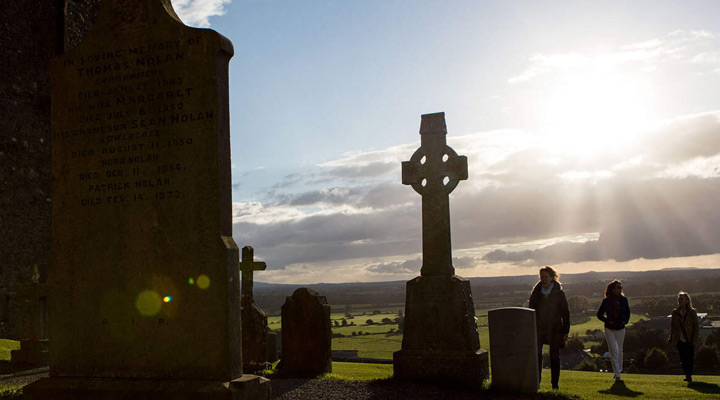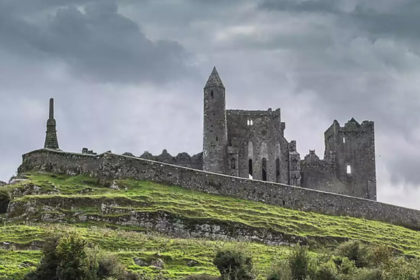What is the Rock of Cashel?

The Rock of Cashel, also known as Cashel of the Kings and St. Patrick’s Rock, stands as one of Ireland’s most popular and breathtaking historic sites. Sitting in the heart of Cashel in County Tipperary, this 12th-century marvel is often mentioned alongside other top tourism spots in the province of Munster, including the Cliffs of Moher, Blarney Castle, the Burren National Park, and Spike Island. With over 350,000 visitors each year, it should come as no surprise that the legend behind the Rock of Cashel is a very special one indeed!

The legend of Rock of Cashel
The legend of the Rock of Cashel predates the arrival of the saints to the Emerald Isle, when Ireland was a pagan hotspot. Back then, this little country of ours was known affectionately as the gateway to Hell, sitting ominously on the edge of the known world, and acting as the Devil’s personal shortcut between Hell and Earth. It was the arrival of Patrick, a missionary from the 5th-century, intent on spreading the word of Christianity, that would later set the legend of the Rock of Cashel in motion. Hunting down the Devil proved tricky for Patrick, who evaded the eventual Patron Saint of Ireland for a very long time. Eventually, Patrick was approached by an old man from Templemore, another town located in Tipperary, who told him that the mountains of Tipperary had a peculiar smell coming from them that could only be the brimstone boy.
Patrick, fearless as he was, decided to corner the Devil, bringing a young drummer boy for protection. Sure enough, sitting inside a cave in the mountain sat the Devil, two monstrous slimy snakes, and the great stink of rotten sulphur. Patrick knew he would need to defeat the Devil and run those snakes out of town before the former would plunge Europe into the Dark Ages. Patrick made light work of the first snake, hurling his hissing body against the wall of the cave. The second snake did not hang around for long after that, slithering out of the cave and hastily departing Ireland, taking with him all the other snakes that inhabited the island. It’s this part of the story that would later credit Saint Patrick with eradicating all snakes from the island of Ireland.

Patrick then turned his attention to the Devil, who knew that this missionary was a powerful adversary indeed. The Devil raised an invisible barrier that kept Patrick from advancing. How was the barrier broken you ask? The drummer boy that had accompanied Patrick began to play a gentle but steady rhythm on his drum, enraging the Devil, and forcing him to make a dash out of the cave. Patrick decided to take his chance, and also fled the cave in chase of the Devil. What ensued was an epic battle set atop the valleys of Tipperary, with both the Devil and Patrick flying about the hills trying to gain the upper hand. Legend has it that at one stage Patrick even caught hold of the Devil’s tail, but had to immediately let go as it burned like the fires of Hell.
Fearing that he would eventually become cornered by Patrick, the Devil bit a chunk out of the mountains, eager to escape through the gap he made! Patrick could do no more, and returned down the mountain with the drummer boy by his side. As he made his way back to the depths of Hell, the Devil spat out the large rock from his mouth which travelled across the skies of the Premier County, before landing in the heart of Cashel. That is the legend of the Rock of Cashel. Next time you find yourself in Tipperary, look to where the Devil made the gap in the mountains near Templemore, this is now known as the Devil’s Bit. Then compare that peculiar gap in the landscape with the Rock of Cashel and try telling me they are not the exact same size!

Cashel would go on to become the site of the conversion of the King of Munster to Christianity by Saint Patrick. Hence the Rock of Cashel became the traditional seat of the kings of Munster for hundreds of years. In 1101, the King of Munster and great-grandson of Brian Boru, Muirchertach Ua Briain donated his fortress on the Rock of Cashel to the Church. This complex stands today as one of the most astonishing collections of Celtic art and medieval architecture found anywhere across Europe. While few remnants of the early structures survive, the vast majority of buildings found on the Rock of Cashel today date back to the 12th and 13th centuries, making it a must-see on your next excursion to Tipperary!



